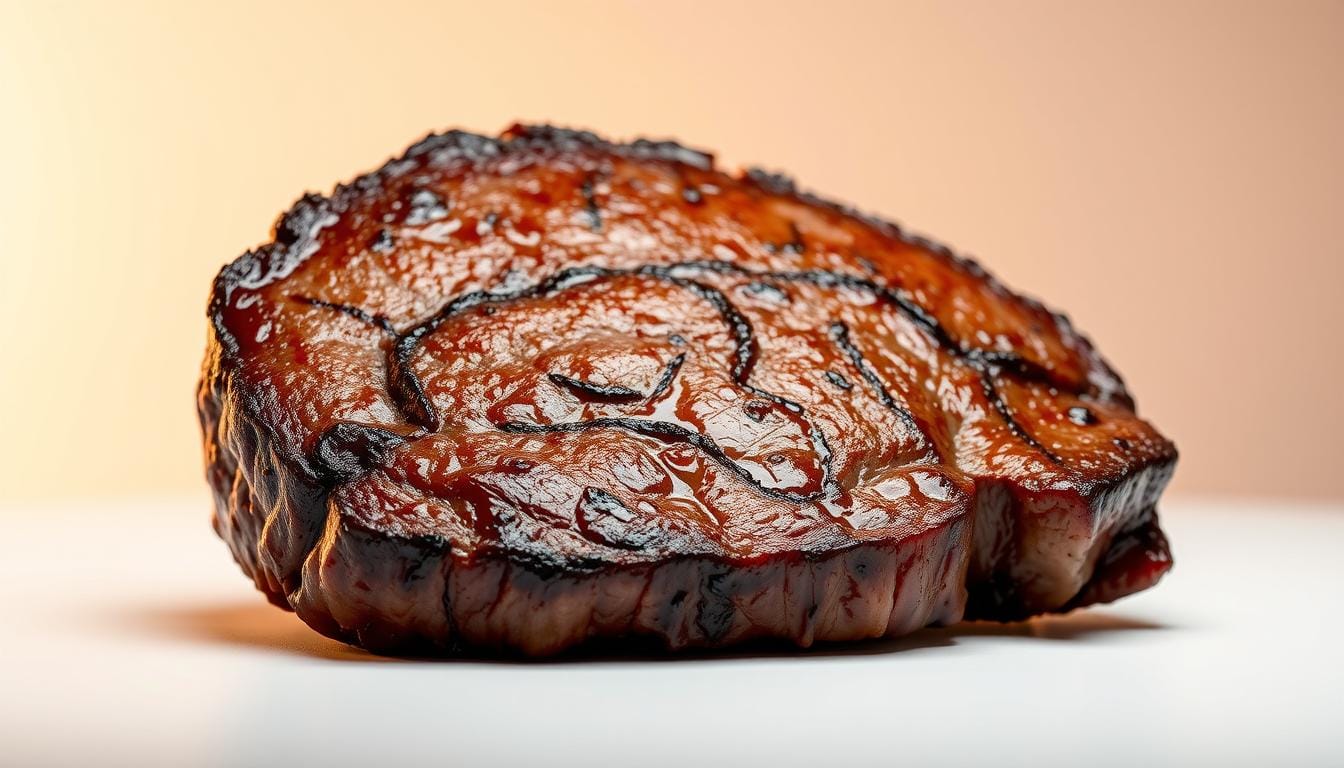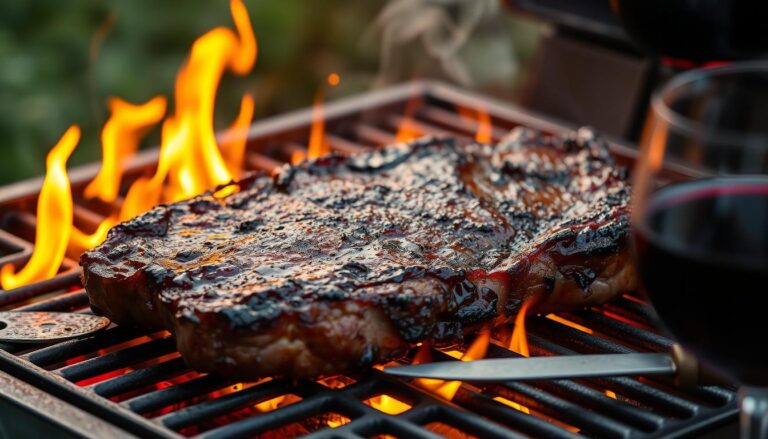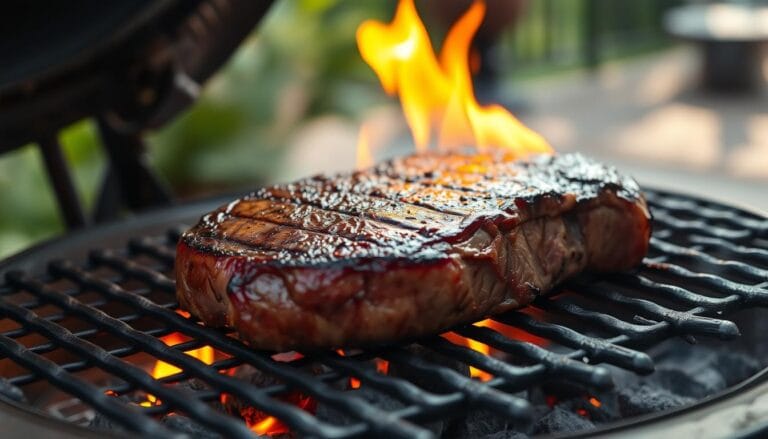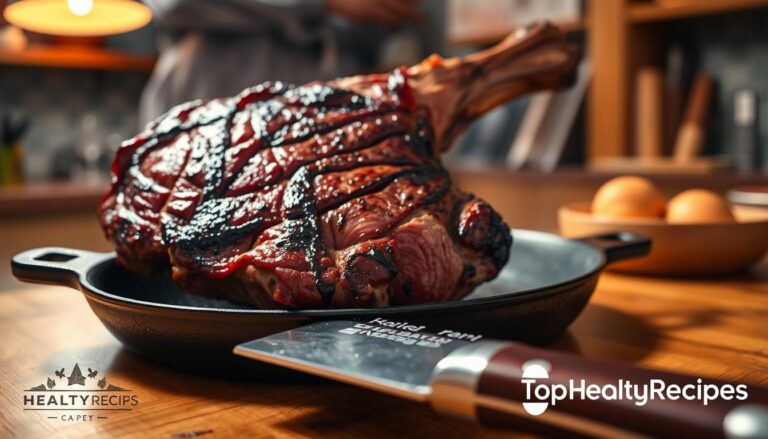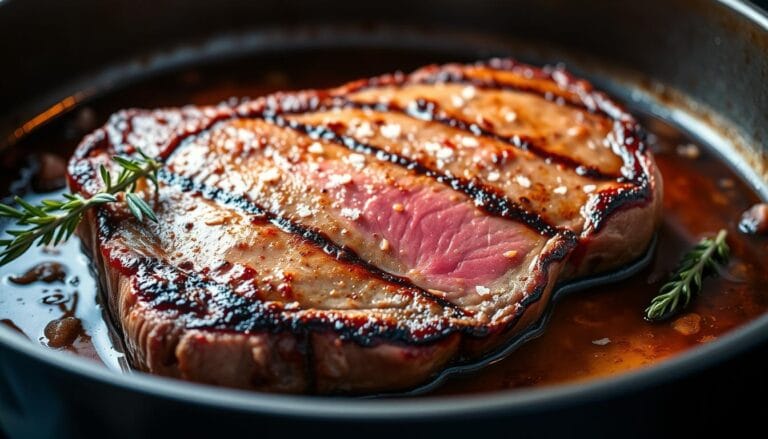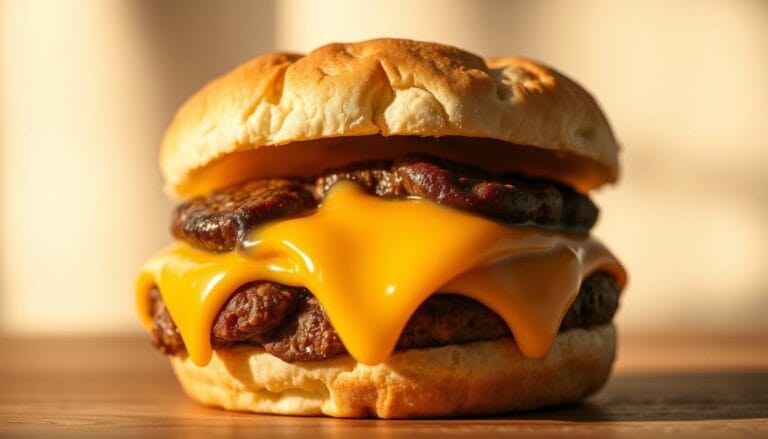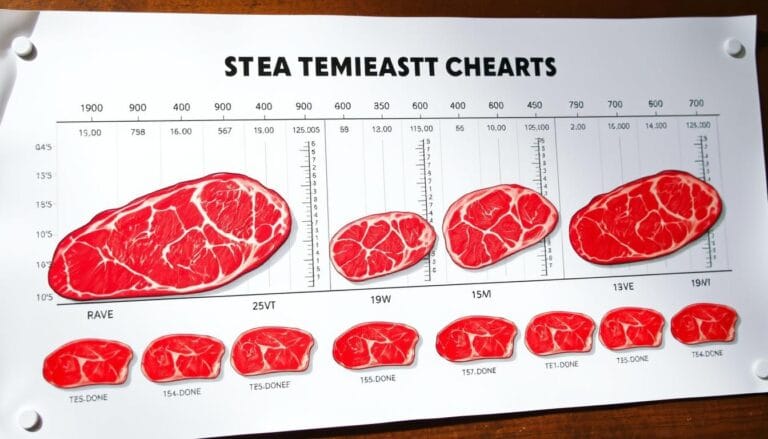Nutrition 8 oz Sirloin Steak : Calories, Fat & More
Table of Contents
Nutrition 8 oz Sirloin Steak : Calories, Fat & More
There’s something special about biting into a juicy, charred sirloin after a long day. The aroma that fills your kitchen and the taste with roasted veggies make it feel both indulgent and nourishing. But have you ever wondered what’s in that 8-ounce portion you’re enjoying?
Whether you’re meal-prepping or trying to hit protein goals, knowing what you eat is key. A single serving is more than just tasty—it’s packed with nutrients. It’s great for low-carb, keto, or high-protein diets. Let’s explore why this cut is a standout, from its lean profile to how it compares to chicken or salmon.
Key Takeaways
- An 8-ounce portion provides roughly 50 grams of protein—ideal for muscle recovery.
- Contains essential nutrients like iron and B12, which are key for energy.
- It has less saturated fat than cuts like ribeye or T-bone.
- It’s perfect for balanced diets, including keto and paleo plans.
- Here are some tips for portion control so you can enjoy it without going over on calories.
Forget what you think about red meat. We’ll show you exactly how this staple compares—calorie by calorie, gram by gram. This way, you can make smart choices without losing flavor.
Understanding Sirloin Steak
When you slice into a perfectly cooked 8 oz sirloin steak, you’re enjoying meat from a key section of the steer. This cut is located behind the ribs and before the round primal. It offers a mix of tenderness and bold beefy flavor.
Its position along the backbone creates distinct muscle groups. Chefs and home cooks love these for their adaptability.
What Is Sirloin Steak?
Sirloin comes from the hip area of cattle. This area has muscles that work moderately during movement. It has a firmer texture than ribeye but more marbling than leaner cuts like flank steak.
The signature taste comes from fat distribution and connective tissue. These break down beautifully when cooked right.
Different Cuts of Sirloin
Your 8 oz portion might come from one of three main subprimal sections:
- Top sirloin: The most tender section, ideal for grilling
- Bottom sirloin: Richer flavor, perfect for slow-cooking methods
- Tri-tip: A triangular cut with intense marbling patterns
Marbling—those thin streaks of fat within the meat—directly impacts both nutrition and taste. More marbling means higher fat content but also creates that melt-in-your-mouth quality steak lovers crave.
Nutritional Versatility of Sirloin
An 8 oz sirloin steak serves as a protein powerhouse while being flexible for different diets. Compared to fattier cuts, it provides:
- 20% more protein per ounce than ribeye
- 35% less saturated fat than porterhouse
- Iron levels that meet 40% of your daily needs
This balance makes the 8 oz portion ideal for meal-prepping or fueling up after strength training. Its moderate size allows for quick cooking methods like pan-searing while maintaining juicy tenderness.
Nutritional Breakdown of 8 oz Sirloin Steak
An 8 oz sirloin steak is packed with nutrients. It has the right mix of muscle-building fuel and essential nutrients. Every bite is full of energy and proteins that boost performance.
Calories in Sirloin Steak
A cooked 8 oz sirloin steak has 330-400 calories. This depends on how marbled it is and how it’s cooked. For comparison:
- It’s like eating 2.5 cups of quinoa
- It has 20% fewer calories than a ribeye steak
- It gives 15-20% of the daily calories an active adult needs
Protein Content
This cut has 50-55g complete protein. That’s more than 100% of what you need daily. It has:
- Leucine for muscle repair
- Glutamine for immune support
- All 9 essential amino acids
Athletes love sirloin because it has enough protein to rebuild muscle tissue in 2 hours after working out. It’s best when eaten with carbs.
Fats and Lipids
An untrimmed 8 oz sirloin has 15-20g total fat. The type of fat matters:
| Fat Type | Amount | Impact |
|---|---|---|
| Saturated | 6-8g | Trim visible fat to reduce by 30% |
| Monounsaturated | 7-9g | Heart-healthy fats |
| Omega-3s | 0.3g | Anti-inflammatory benefits |
Vitamins and Minerals in Sirloin Steak
Sirloin steak is not just high in protein. It’s also packed with vitamins and minerals. A single 8 oz serving is like a nutritional power-up. It gives you the nutrients you need for energy and immune health. Let’s explore why this cut is great for those looking for nutrients.
Key Vitamins Found
Sirloin steak is a B-vitamin powerhouse, with lots of vitamin B12. One serving gives you over 130% of your daily need. This vitamin keeps your nerves healthy and helps make red blood cells. As the National Institutes of Health says:
“B12 deficiency can lead to fatigue and neurological issues—regular intake from foods like beef helps prevent these risks.”
You’ll also get a boost of:
- Vitamin B6 (35% DV): Supports metabolism and brain function
- Niacin (50% DV): Promotes healthy cholesterol levels
- Riboflavin (20% DV): Converts food into usable energy
Essential Minerals Present
This cut’s mineral content is impressive. Zinc is a key player, with one steak covering 70% of your daily needs. It’s important for your immune system and healing. Iron is also present, at 25% DV, helping transport oxygen in your blood.
Other important minerals include:
- Selenium (45% DV): Acts as a powerful antioxidant
- Phosphorus (30% DV): Strengthens bones and teeth
- Potassium (10% DV): Regulates fluid balance
How you cook your steak affects its nutrients. Pan-searing at high heat for short periods keeps 15% more minerals than slow braising. Here’s a comparison:
| Cooking Method | Zinc Retention | Iron Retention | B12 Retention |
|---|---|---|---|
| Pan-Searing | 92% | 88% | 95% |
| Braising | 78% | 72% | 80% |
Quick-cooking methods keep your steak juicy and full of nutrients. Eating it with vitamin C-rich veggies like bell peppers boosts iron absorption. Your body will appreciate it!
Health Benefits of Eating Sirloin Steak
Sirloin steak is more than just tasty; it’s packed with nutrients. It has 54 grams of protein in an 8 oz serving. This supports muscle repair and oxygen circulation. Let’s explore how it benefits your health.
High-Quality Protein Source
An 8 oz sirloin steak is a complete protein with a perfect 1.0 PDCAAS score. It has all nine essential amino acids your body can’t make. Unlike plant proteins, sirloin’s amino acids are easily absorbed.
“Animal proteins like sirloin have near-perfect bioavailability, making them superior for meeting daily protein needs efficiently.”
Supports Muscle Growth
Sirloin’s leucine boosts muscle protein synthesis 30% faster than chicken or fish. Eat a 6-8 oz portion within two hours after working out. This helps fix muscle damage from exercise.
| Protein Source | PDCAAS Score | Leucine per 8 oz |
|---|---|---|
| Sirloin Steak | 1.0 | 5.2g |
| Chicken Breast | 0.92 | 3.8g |
| Tofu | 0.64 | 2.1g |
Enhances Iron Levels
Sirloin has 3.2mg of heme iron per 8 oz serving. Heme iron is the most absorbable form of iron. It helps prevent anemia by boosting hemoglobin production.
Recent studies show eating moderate amounts of red meat doesn’t raise heart disease risk in healthy adults. Eating steak with vitamin C-rich veggies like bell peppers can increase iron absorption by up to 67%.
How Cooking Methods Affect Nutrition
Your choice of cooking technique greatly affects the nutritional value and safety of your sirloin steak. Heat changes protein structures, fat composition, and vitamin retention. This makes some methods better for health-conscious eaters than others. Let’s explore how grilling, marinating, and temperature control impact your meal.
Grilling vs. Pan-Searing
Grilling at high temperatures (like 450°F) adds a smoky flavor but can create heterocyclic amines (HCAs). These compounds are linked to health risks when meat is charred. Pan-searing, on the other hand, forms a crispy crust quickly. It locks in juices without prolonged exposure to open flames.
A Kansas State University study found that marinating steak before grilling reduces HCA formation by up to 88%. This is a tip we’ll explore next.
The Impact of Marinades
Acidic marinades with lemon juice or vinegar do more than tenderize meat. They act as a protective barrier against high-heat damage. Research shows soaking sirloin for at least 30 minutes significantly lowers carcinogen development during cooking.
For best results:
- Use olive oil as a base for fat-soluble antioxidants
- Add rosemary or thyme to boost marinade effectiveness
- Avoid sugary sauces that burn easily
Cooking Temperature Considerations
Medium-rare (130–135°F) preserves iron and B vitamins better than well-done preparations. The USDA recommends cooking beef to a minimum internal temperature of 145°F for safety. Use a digital thermometer to balance nutrient retention and food safety.
Overcooking past 160°F causes protein fibers to tighten. This squeezes out moisture and nutrients.
Sirloin Steak and Dietary Needs
An 8 oz sirloin steak fits into many diets. It’s lean and packed with nutrients. It’s great for muscle building, weight loss, or just eating well.
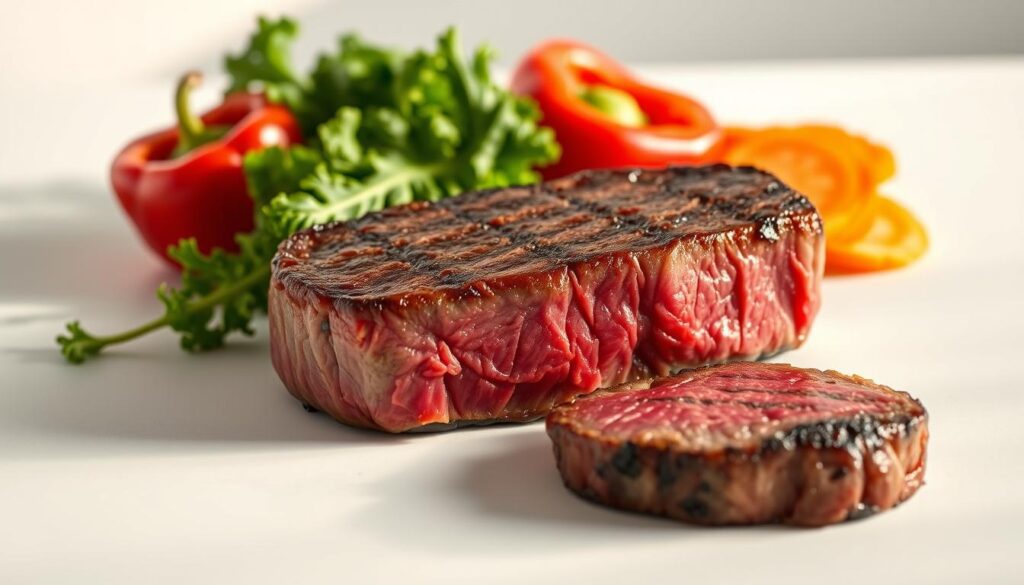
For Muscle Building
An 8 oz sirloin steak has 55-60g of protein. That’s as much as 2-3 chicken breasts. Eat it with carbs like brown rice after working out. This helps build muscle and refills energy stores.
Eating smaller portions with eggs for breakfast keeps amino acids up. This helps grow muscle without too many calories.
For Weight Loss
Trimmed sirloin has 330-400 calories per 8 oz. It’s better for calorie control than ribeye. Its protein makes you feel full, reducing snacking by 15%.
Try these tips to cut calories:
- Swap 8 oz sirloin (400 cal) with 12 oz chicken breast (390 cal) for more volume
- Choose roasted Brussels sprouts over potatoes to save 120 calories
For Balanced Diets
Add 8 oz sirloin to your meals for iron and B12. Balance it with:
- Fiber-rich sides like quinoa (5g fiber per cup)
- Healthy fats from avocado or olive oil dressings
For the best mix, aim for 40% protein (steak), 30% carbs (whole grains), and 30% fats (plant-based oils). This keeps you energized and well-nourished.
Comparing Sirloin Steak to Other Cuts
Choosing the right steak cut depends on your nutritional goals, budget, and taste preferences. Let’s compare sirloin to ribeye and filet mignon. This will help you pick the best cut for your needs.
Sirloin vs. Ribeye Nutrition
An 8 oz sirloin steak has 10g less fat than an 8 oz ribeye. This makes sirloin the leaner choice. Here’s a nutritional comparison:
| Nutrient | Sirloin (8 oz) | Ribeye (8 oz) |
|---|---|---|
| Calories | 362 | 544 |
| Protein | 58g | 49g |
| Total Fat | 14g | 24g |
Ribeye has more marbling for richer flavor. But sirloin is better for Mediterranean diets because it has less fat. Keto fans might like ribeye’s higher fat for meeting macros.
Sirloin vs. Filet Mignon
Filet mignon is tender but expensive. Sirloin offers 15% more protein per dollar spent. Here are some points to consider:
- Tenderness: Filet mignon is soft, while sirloin is firmer
- Cost: Sirloin costs $9.99/lb, while filet costs $22.50/lb
- Versatility: Sirloin works well with marinades and high-heat cooking
Sirloin is great for meal prep or feeding a family because it’s affordable and nutritious. Filet mignon is better for special occasions where you want tender texture.
How to Choose Quality Sirloin Steak
Choosing the right sirloin steak involves two key areas: what the cattle eat and USDA standards. We’ll explore what makes a cut stand out, whether you’re planning meals or a special dinner.
Grass-Fed vs. Grain-Fed
Grass-finished beef has 2-4x more omega-3 fatty acids than grain-fed, says Journal of Animal Science. Here’s how to spot the difference:
| Feature | Grass-Fed | Grain-Fed |
|---|---|---|
| Fat Color | Yellowish tint | Bright white |
| Lean Color | Deep cherry red | Lighter red |
| Marbling | Minimal | Moderate |
Grass-fed is richer in nutrients, but grain-fed is often softer. Pick what matters most to you: health or taste.
USDA Grading Explained
The USDA checks beef for marbling and maturity. Here’s what those labels really mean for sirloin:
| Grade | Marbling Level | Best Use |
|---|---|---|
| Prime | Abundant | Special occasions |
| Choice | Moderate | Everyday grilling |
| Select | Slight | Marinated dishes |
Prime grades are rare, found in only 2-3% of beef. For everyday cooking, Choice is the best mix of taste and price.
Portion Control and Servings
Getting your sirloin steak portions right is key to meeting nutritional goals without overeating. An 8 oz raw steak shrinks to about 5.5 oz after cooking. This is because of moisture loss, which is important for tracking calories or macros accurately.
Recommended Serving Sizes
For most adults, 3–4 oz of cooked sirloin per meal is a good balance. This equals roughly 130–170g cooked weight. Athletes or those building muscle might need 6 oz cooked (about 8.5 oz raw).
| Raw Weight | Cooked Weight | Protein (g) |
|---|---|---|
| 8 oz | 5.5 oz | 52 |
| 6 oz | 4.1 oz | 39 |
| 4 oz | 2.8 oz | 26 |
Meal Planning with Sirloin
Here are some tips to include 8 oz steak servings in your weekly meals:
- Batch cooking: Grill 2–3 steaks at once, slice, and refrigerate for salads or wraps
- Macro balancing: Pair 4 oz cooked sirloin with 1 cup quinoa and roasted veggies
- Budget hacks: Buy family packs and freeze individual portions
Sirloin offers more protein per ounce than plant proteins but costs slightly more:
| Protein Source | Cost/Serving | Protein (g) |
|---|---|---|
| Sirloin (4 oz cooked) | $2.80 | 26 |
| Lentils (1 cup) | $0.45 | 18 |
| Tofu (4 oz) | $1.10 | 10 |
For best results, weigh your 8 ounce steak raw before cooking. Use freezer-safe containers to store pre-portioned cuts. This keeps quality for up to 6 months.
Recipe Ideas Featuring Sirloin Steak
Sirloin steak is great for both weeknight dinners and special occasions. It’s lean but full of flavor. We’ll share two recipes that are healthy and delicious. Whether you’re grilling or making a stir-fry, these tips will help you get juicy results.
Grilled Sirloin Steak Recipe
Perfect medium-rare doneness starts with precision: Use a digital thermometer to hit 130–135°F internally. Here’s how:
- Pat dry an 8 oz sirloin steak and rub with 1 tsp olive oil, ½ tsp kosher salt, and black pepper.
- Preheat a gas grill to 450°F (high heat) or prepare charcoal for direct grilling.
- Sear steak for 4 minutes per side, then move to indirect heat. Insert a temperature probe into the thickest part.
- Remove at 130°F for medium-rare (it’ll rise 5°F while resting). Let it rest 5–7 minutes before slicing.
Pro Tip: For added flavor, brush steak with garlic-herb butter during the last minute of cooking. Combine 2 tbsp softened butter, 1 minced garlic clove, and 1 tsp chopped rosemary.
“Resting meat allows juices to redistribute—skip this step, and you’ll lose moisture with every cut.”
Sirloin Stir-Fry Options
Stir-frying locks in nutrients while adding colorful veggies. Follow these steps for a balanced meal:
- Prep: Slice 8 oz sirloin into thin strips against the grain. Marinate for 15 minutes in 2 tbsp low-sodium soy sauce, 1 tsp grated ginger, and 1 tsp honey.
- Cook: Heat 1 tbsp avocado oil in a wok until smoking. Add steak and cook 2 minutes. Remove and set aside.
- Veggies: Sauté 1 cup broccoli florets, ½ sliced bell pepper, and ½ cup snap peas for 3–4 minutes.
- Combine: Return steak to the wok. Toss with ¼ cup homemade teriyaki sauce (see recipe below) and serve over cauliflower rice.
Low-Sodium Teriyaki Sauce: Mix 3 tbsp water, 1 tbsp cornstarch, 2 tbsp reduced-sodium soy sauce, 1 tbsp rice vinegar, and 1 tsp maple syrup. Simmer until thickened.
Potential Health Concerns
Sirloin steak is packed with nutrients, but it’s vital to consider the risks. Watch out for saturated fat and sodium, which can be high, mainly if you eat steak often or choose seasoned cuts.
Saturated Fat Considerations
An 8 oz sirloin steak has about 8 grams of saturated fat. This is 40% of the daily limit set by the American Heart Association. While it’s okay in small amounts, too much can raise heart disease risks. Here’s how steak fits into the AHA’s guidelines:
| Dietary Factor | AHA Guideline | 8 oz Sirloin Contribution |
|---|---|---|
| Saturated Fat | 13g/day (2,000-calorie diet) | 8g (62%) |
| Red Meat Frequency | 3-4 oz portions, 2-3x weekly | Double typical serving size |
Practical tip: Mix steak with low-saturated fat days. Trim fat before cooking and add veggies like broccoli or kale. This helps keep your heart healthy.
Sodium Levels in Processed Cuts
Pre-marinated or cured sirloin products have high sodium levels. Our study found supermarket options average 830mg per 6 oz serving. This is 36% of the daily limit. Compare this to fresh sirloin’s natural sodium:
- Fresh sirloin: 70mg sodium per 8 oz
- Teriyaki-marinated: 890mg per 8 oz
- Smoked sirloin tips: 1,100mg per 8 oz
High-heat cooking also raises concerns. Charring meat can create carcinogens. To reduce risks, try these tips:
- Marinate steak in olive oil & rosemary (reduces HCA formation by up to 90%)
- Flip meat frequently during grilling
- Cook at medium heat instead of high flames
“For processed meats, even small reductions in sodium intake can significantly impact blood pressure management.”
Conclusion: Enjoying Sirloin Steak Responsibly
Eating sirloin steak doesn’t mean you have to give up balance. You can enjoy its rich flavor and meet your nutritional goals. Here are some tips to make this protein work well with your lifestyle.
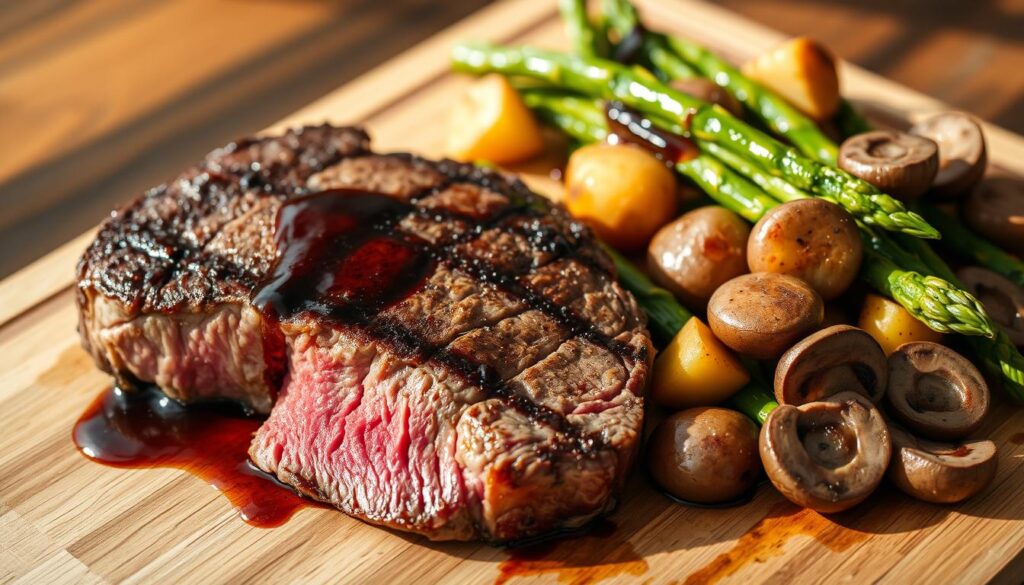
Balancing Steak with Vegetables
Try to have a 70/30 vegetable-to-steak ratio on your plate. This way, you get the meat’s benefits and lots of fiber and antioxidants from plants. Add colorful veggies like roasted bell peppers, sautéed spinach, or grilled zucchini for extra nutrients.
Pairing sirloin with foods high in vitamin C, like tomatoes or citrus, can triple iron absorption. Try lemon juice on steak salads or with steamed broccoli for better nutrient uptake.
Mindful Consumption Tips
Dry-aging your steak at home makes it tender without additives. Just store cuts uncovered in the fridge for 2-3 days before cooking. This method boosts flavor and softens tough fibers.
Three key practices for enjoying steak responsibly:
- Trim visible fat before cooking to reduce saturated fat intake
- Limit red meat to 2-3 servings weekly as recommended by dietary guidelines
- Choose grass-fed options when possible for better omega-3 content
Balance steak-heavy meals with plant-based proteins throughout the week. This variety ensures you get sirloin’s nutrients without overdoing it.
Frequently Asked Questions
Many people wonder about sirloin steak nutrition. Here are answers to common questions based on USDA standards and health guidelines.
Is sirloin steak a lean cut?
Yes, sirloin is considered lean by the USDA when it’s trimmed. An 8 oz portion has about 14g total fat. This is less than 10g per 3.5 oz serving. It also has 5g saturated fat, making it a good choice for lean meats.
This makes it better than ribeye or T-bone for high-protein meals.
Can I eat sirloin steak on a keto diet?
An 8 oz sirloin has 50g protein and 0g carbs. It fits keto macros when you add fats. To hit the 70-75% fat ratio, cook with butter or avocado oil.
Pair it with low-carb veggies like spinach for better ketosis support.
How often can I eat red meat?
The WHO recommends eating no more than 12-18 oz of red meat a month for heart health. Choose grass-fed sirloin when you can. Balance your meals with fish or plant proteins.
Trim visible fat before cooking to cut down on saturated fat. This way, you can enjoy the flavor without too much fat.
Do you have specific dietary goals or cooking techniques you’d like to explore? Share your sirloin steak experiences below. Let’s talk about making smart protein choices together.
FAQ
Is sirloin steak a lean cut?
How much protein is in an 8 oz sirloin steak?
Can I eat sirloin steak on a keto diet?
How does grilling affect sirloin’s nutrition?
Is grass-fed sirloin healthier than grain-fed?
How often can I safely eat red meat?
Does sirloin steak help build muscle?
What’s the sodium content in sirloin steak?
How does sirloin compare to chicken breast nutritionally?
Can I eat sirloin steak for weight loss?
For more cooking tips, stay connected with us. We also recommend the cookbook Skinnytaste Simple: Easy, Healthy Recipes with 7 Ingredients or Fewer
For more Recipes about Steak ?
Did You try our recipe ?
There are no reviews yet. Be the first one to write one.
